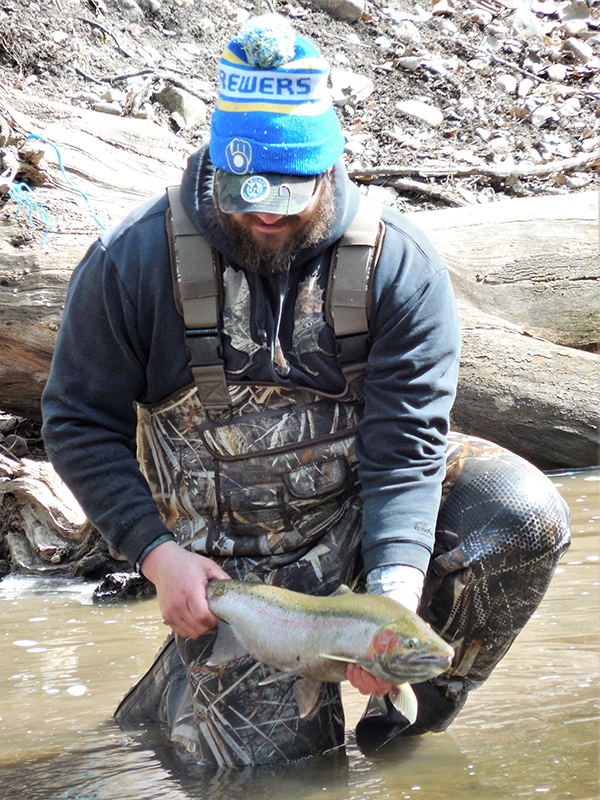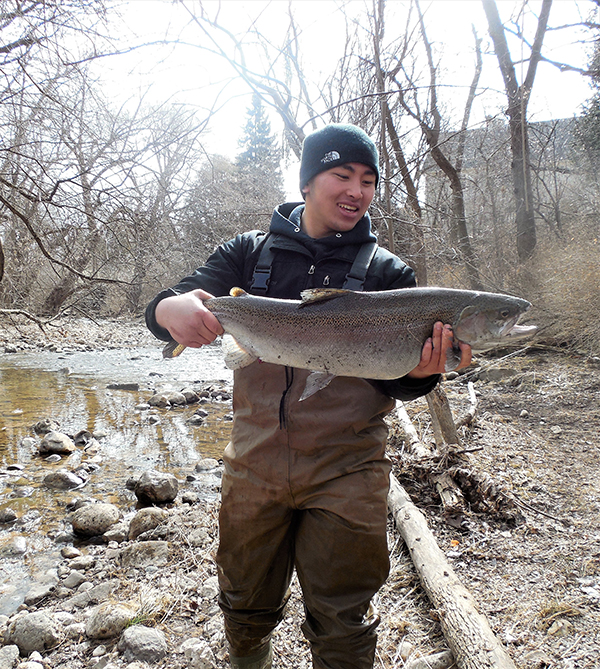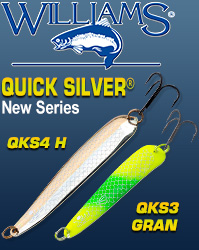Steelhead on the Southeastern Wisconsin tributaries of Lake Michigan
(Small Water, Big Fish, and Big Fun)
By John Luthens
A swirling chill circled in the Lake Michigan morning and crested the waves in the Wisconsin harbor city of Port Washington as I stood on the lip of the brushy valley of Sauk Creek, a winding and rocky snake that pushes itself through the quiet town before meeting the lake in the marina harbor on the east end of town.
Along an icy wall below the urban banks, flies and spinners were already ticking on the surface of the pool, my two fishing companions for the day, Sa Lee and Zack Regazzi, both of Oshkosh, Wisconsin, steadfastly warming up to their trade in the early-morning waters.
“Four fish tailing at head of the pool earlier, Lee said with a bright smile. “Zack took one on a stonefly, and the water is super low. We couldn’t have missed them if they’d have splashed upstream. They’re still sulking in here somewhere.”

Zack Regazzi of Oshkosh releases a steelhead back into the morning waters of Sauk Creek.
Regazzi blew warmth into fingers and broke pieces of ice from his rod guides, continuing to watch his strike indicator with his polarized glasses reflecting the rising sun and the moving current of Sauk Creek. He might have been too cold talk, or he might have been lost in the moment, watching for the slightest shadow movement in the pool below. In the frying-pan waters of early-season steelhead – both of these traits scramble together like eggs in a spawn sac.
Spring weather can be chancy statewide, and the combination of wind and water along the Lake Michigan shore might amplify a light breeze into a bone-chilling hurricane. But for southeastern Wisconsin steelhead fishermen, wind, rain or snow, and the big fish that follow are given rites of the season.
From the Root River in Racine County and the Milwaukee River running through its concrete walls, all the way to the Sheboygan and Manitowoc flowing through the upper lake shore counties, steelhead trout push onto the tributaries from the big lake to spawn, and fishermen start monitoring the weather and laying out their best, cold-weather, waterproof gear and heaviest rods and nets to try to intercept them.
While not necessarily be conducive to fishermen, a cold downpour or slushy, wet snow squall is a green light to start fish up the river, providing them easier access to higher points along the stream. Water level becomes the key indicator to the amount of fish in tributary as well as how high up the river they tend to be found.
Our own steelhead foray had been foreshadowed by several weeks of cold, dry, windy conditions, and the water was indeed low as Lee had stated. Rocks yawned through the Sauk Creek morning like jagged teeth along the mouths of riffles, forcing us to do what any die-hard steelhead fisherman would do when an early-spring getaway presents itself with less than ideal conditions. Regardless of Mother Nature’s whims, we hit the water with hopeful abandon.
Wading in the rippling water and wind, we offered spawn, streamers and nymphs, switching to fluorescent beads and yarn flies that mimic single eggs. Between casts we warmed the air with stories of past waters and steelhead conquest, stretching the truth when necessary and lying outright when we were backed into a corner, which is the grim and proper way for any good steelhead campaign to get underway. After an hour, with nothing to show but aching casting wrists and frozen ears, we unanimously voted to rest the pool and warm up by moving downstream for a bit of exploring.
Now, it should be stated that fishing along many of the Lake Michigan tributaries is unique in respect to its environmentally urban surroundings. The distant sound of tires on asphalt overshadow the murmuring of tranquil water, and houses, schools and factories take the place of tall, overhanging pines. Weekends during the height of the run tend to draw crowds of fishermen, and an angler looking to have the choice pick of water might be better served wading mid-week.
And still, despite its bustling environment, a steelhead watershed rolling through the heart of a city offers an abundance of natural distractions: Robins challenging chickadees in the tangled brush along the banks, the birds of summer huddling in quiet misery and the birds of winter celebrating their last hurrah. Urban deer prints wandered in aimless circles along the sandy flats, merganser ducks paddled in frantic wakes and woodchucks scurried beneath the roots as we waded back and forth across the shallow streambed to pluck flies and lures into our tackle boxes; lost treasures snagged in the unreachable trees and brush piles on a forgotten weekend when the flow was high and roaring.
Low water, while not necessarily yielding sheer numbers of fish, can offer fantastic sight fishing and reveal steelhead trout in the most unexpected of places: Deeper cuts in the gravel, leaning trees, slack water downstream of large rocks, anyplace a migrating fish can rest before pounding itself further up the rocky backbone and shallow push of current. Often there’s a flash of silver or the darting flip of a square tail, sometimes only a fleeting shadow that catches itself between the corner of one’s eye and the imagination.
“That’s a big fish,” Regazzi whispered, “I think it would best my personal record!” A submarine rolled from beneath a fallen log in a narrow channel and slid beneath a root pile along an undercut bank. “Go slow. Maybe we can get him to chase.” Ducks, woodchucks and the scavenger hunt for lost fishing flies were forgotten in the moment. Our steelhead game was finally afoot.
Regazzi twisted precariously over the log and drifted egg flies down and across the pool, while Lee knelt at the tail throwing spawn sacs as close to the undercut bank as he could without becoming hopelessly tangled in the gnarled roots. Myself, I climbed a leaning tree above the bank, partly to call down coordinates on how close the flies were drifting in relation to the wavering steelhead below, but mostly to get out reach of the frigid, splashing water when the monster struck. It was only a matter of time and patience.

Sa Lee of Oshkosh with a beautiful, Lake Michigan tributary steelhead.
“He’s on! You hooked him fair in the mouth!” Line hissed through the early-spring as the fish hit Lee’s spawn fly, dragging him through the pool, his rod bending double into the water beneath the steelhead’s coveted log jam. Regazzi stumbled over the rocks for the net as thirty-inches of angry silver shook its head and leaped into the air like an oversized puppy playing tug-of-war on the end of a rope.
The rocky shallows above the pool probably saved the moment. The reel drag was groaning and Lee’s line was taut beneath the fallen log, but the fish seemed unwilling to bash its body up the jagged riffles. A big steelhead with a passable escape route can jump two bends up in a blink of an eye and snap a rod in half. A few errant passes with the net, and 5 solid pounds of lake-run silver lay on the graveled shore.
Shaking hands all around, we admired the fish before moving on with the rising day. The sun climbed higher above the Port Washington shores to bathe the bottoms in the warm, brown light that only early-spring in Wisconsin seems to muster. Whether from the slow, southward slant of the sun or the warm glow of victory that comes with landing a mighty fish, the chilly air and water had lost the sharpness of its sting. Steelhead fishing along the winding tributaries of the Lake Michigan shore can turn up the heat in a splashing hurry.
John Luthens is a freelance writer from Grafton, Wisconsin. His first novel, Taconite Creek, is available on Amazon or at www.cablepublishing.com or by contacting the author at Luthens@hotmail.com









